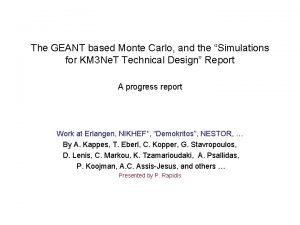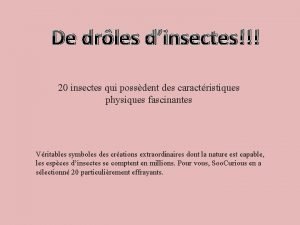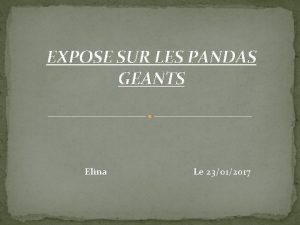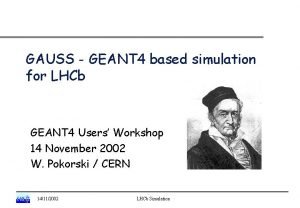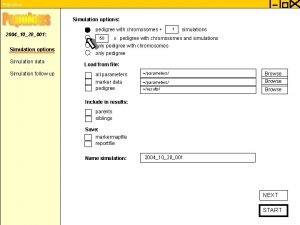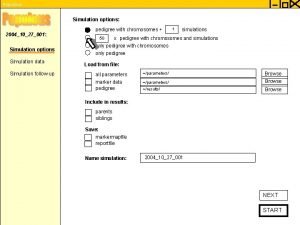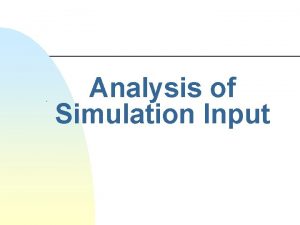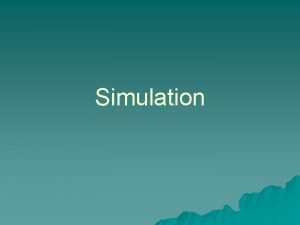Some GEANT 4 exercises GEANT 4 simulation of















- Slides: 15

Some GEANT 4 exercises…

GEANT 4 simulation of the diamond test setup Sr 90 PA diamond Scint. PM 1 PM 2 discr delay ADC & Gate Sr Emip = 1. 5 Me. V d. E/dx = 5. 57 Me. V/cm R = 0. 2 cm Sr Sr Y Y Task: E, Me. V to understand improve the built setup… • are the electrons MIP? • is the ionization homogeneous in diamond? • can be geometry improved? MIP

GEANT 4 geometry + source Source: GE AN T RE AL G 4 General. Particle. Source or G 4 Radioactive. Decay or your own. . . setup_geometry. cc : G 4 User. Limits *l = new G 4 User. Limits(); // Sets a max Step length in the diamond : G 4 double max. Step = 0. 005*mm; l->Set. Max. Allowed. Step(max. Step); diamond_log->Set. User. Limits(l); setup_Primary. Generator. Action. cc setup_Physics. List. LE. cc: ………… void setup_Physics. List. LE: : Set. Cuts(){ Set. Cut. Value(0. 01*mm, "gamma"); Set. Cut. Value(0. 01*mm, "e-"); Set. Cut. Value. For. Others(default. Cut. Value); Dump. Cut. Values. Table(); }


setup_Root. Manager. hh : class setup. Root. Manager{ //singleton public: . . . class setup_diam. Hit : public G 4 VHit{ static setup. Root. Manager* get. Instance(); public: void fill. X(double d. E, …. double x, double y, double z, int ps. N); private: void fill. E(double i. E, double d. E, double s. E); G 4 int track. ID; … G 4 double edep; private: G 4 Three. Vector pos; static setup. Root. Manager* instance; G 4 String pname; TFile* f; …… TNtuple* ntuple. X; } TNtuple* ntuple. E; … setup_diam. SD. hh : class setup_diam. SD : public G 4 VSensitive. Detector{ }; public: … G 4 bool Process. Hits(G 4 Step*, G 4 Touchable. History*); private: setup_diam. Hits. Collection* diam. Collection; }; setup_diam. Hit. hh : setup_Event. Action. cc : void setup. Event. Action: : End. Of. Event. Action(const G 4 Event* an. Event){ setup. Root. Manager* s. RM = setup. Root. Manager: : get. Instance(); // get information from setup_diam. Hits. Collection, . . . // and fill root histo/ntuple/tree… s. RM->fill. E(Eini, diam. Energy, scint. Energy); s. RM->Fill. Something. Else(…) };

energy spectra Diamond – spectrum (energy deposition) for any e- Diamond – spectrum (energy deposition) for triggered e- Initial electrons spectrum for “diamond” e- Initial electrons Spectrum for “triggered” e-

depth distributions all electrons in diamond triggered electrons in diamond

step limits influence - 0. 3 Me. V e. No step limits: => Step size is defined by a process… max Step length = 10 mm : => Step size is defined by the limit

More games… ROOT : )

histogram fitting… Simple? . . TH 1 F * signal = new TH 1 F(…); F 1 * g 1 = new TF 1("g 1", my. Func, min, max, npar); signal->Fit("g 1", "VR"); If the function is not so simple? . . . Signal = Gaus 1 + Landau * Gauss 2 Fit parameters: p[0] = Norm(Gauss 1) p[1] = Mean(Gauss 1) - fixed p[2] = Sigma(Gauss 1) – fixed p[3] = Width(Langau) p[4] = MPV(Langau) p[5] = Area(Langau) p[6] = Sigma(Gauss 2)

Simple fitting for the complicated case… Function: TF 1 * glg = new TF 1("glg", gaulangaufun, 50, 400, 7); Proper initial parameters: p[0] = 100. ; p[1] = 139. 1; p[2] = 17. 7; // from noise gauss p[3] = 5. ; p[4] = 180. ; p[5] = 20000. ; p[6] = 30. ; // signal glg->Set. Parameters(p); And fit it: signal->Fit("glg", "VR"); …. And get: FCN=140. 264 FROM MIGRAD STATUS=FAILED 611 CALLS 612 TOTAL EDM=30. 8846 STRATEGY= 1 ERR MATRIX NOT POS-DEF EXT PARAMETER APPROXIMATE STEP FIRST NO. NAME VALUE ERROR SIZE DERIVATIVE 1 p 0 1. 72541 e+01 9. 99999 e-01 -0. 00000 e+00 -1. 74731 e-03 2 p 1 1. 39100 e+02 fixed 3 p 2 1. 77000 e+01 fixed 4 p 3 4. 91314 e+00 1. 79039 e+00 0. 00000 e+00 -4. 07711 e+00 5 p 4 1. 86918 e+02 2. 33982 e+00 0. 00000 e+00 -4. 67063 e-03 6 p 5 9. 58479 e+03 1. 44047 e+02 0. 00000 e+00 -3. 45415 e-09 7 p 6 2. 74389 e+01 2. 34762 e+00 0. 00000 e+00 8. 24991 e-02

To try to improve the fit… To improve: signal->Fit("glg", "EVR"); // „better error estimation“ … And it takes ~8 times loneger… …. And get: FCN=140. 208 FROM MINOS STATUS=PROBLEMS 4058 CALLS EDM=0. 358165 STRATEGY= 1 ERR MATRIX NOT POS-DEF EXT PARAMETER PARABOLIC MINOS ERRORS NO. NAME VALUE ERROR NEGATIVE POSITIVE 1 p 0 1. 74193 e+01 1. 29294 e+00 1. 08485 e+00 2 p 1 1. 39100 e+02 fixed 3 p 2 1. 77000 e+01 fixed 4 p 3 4. 87816 e+00 1. 56382 e-03 5 p 4 6 p 5 7 p 6 1. 86941 e+02 6. 02893 e-03 9. 58141 e+03 1. 62875 e+02 2. 73866 e+01 1. 06973 e+00 9. 57228 e-01 5120 TOTAL

going back to MINUIT… Actually: ROOT uses MINUIT: signal->Fit("glg", "VR"); <=> g. Minuit->mnexcm("MIGRAD", arglist , 2, ierflg); signal->Fit("glg", “EVR"); <=> g. Minuit->mnexcm("MIGRAD", arglist , 2, ierflg); + g. Minuit->mnexcm("MINOS", arglist , npar, ierflg); Then what is wrong? Probably, too many things are predefined? To use TMinuit class directly (only necessary and optimal things)?

going back to MINUIT… Everything (almost) as in Fortran: TMinuit *g. Minuit = new TMinuit(7); g. Minuit->Set. FCN(fcn); // just Chi 2 arglist[0] = 1; g. Minuit->mnexcm("SET ERR", arglist, 1, ierflg); // UD = 1 for chisqr // Set starting values and step sizes for parameters Double_t vstart[7] = {100, 139. 1, 17. 7, 5. , 180. , 20000. , 30. }; Double_t step[7] = {1 , 0. 1, . 02, . 1, 50, . 3}; g. Minuit->mnparm(0, "PNorm", vstart[0], step[0], 0, 0, ierflg); …………………. . arglist[0] = 1000; arglist[1] =. 01; // with set maxcall and tolerance g. Minuit->mnexcm("MIGRAD", arglist , 2, ierflg); arglist[0] = 200; arglist[1] = 5; // with set maxcall and npar g. Minuit->mnexcm("MINOS", arglist , 2, ierflg);

and we’ve finally got… FCN=140. 388 FROM MINOS STATUS=SUCCESSFUL 357 CALLS 1062 TOTAL EDM=0. 000510439 STRATEGY= 1 ERR MATRIX NOT POS-DEF EXT PARAMETER PARABOLIC MINOS ERRORS NO. NAME VALUE ERROR NEGATIVE POSITIVE 1 PNorm 1. 72476 e+01 2. 44167 e+00 2 PMean 1. 39100 e+02 fixed 3 PSigma 1. 77000 e+01 fixed 4 LSigma 4. 91366 e+00 1. 52320 e-02 5 LMPV 1. 86905 e+02 2. 15345 e-01 -5. 77136 e-01 5. 10611 e-01 6 LNorm 9. 57911 e+03 1. 02587 e+02 7 GSigna 2. 73663 e+01 8. 55687 e-02 Chi 2 LMPV
 Geant simulation
Geant simulation Some, any, no exercises
Some, any, no exercises Ice-cream countable or uncountable
Ice-cream countable or uncountable Some trust in horses
Some trust in horses Force and motion
Force and motion Sometimes you win some sometimes you lose some
Sometimes you win some sometimes you lose some Some say the world will end in fire some say in ice
Some say the world will end in fire some say in ice God when you choose to leave mountains unmovable
God when you choose to leave mountains unmovable Some say the world will end in fire some say in ice
Some say the world will end in fire some say in ice Blatte rhinocéros
Blatte rhinocéros Le géant atlas dans son café de bonsecours
Le géant atlas dans son café de bonsecours Pub geant
Pub geant Le plus grand tractopelle du monde
Le plus grand tractopelle du monde Exposé panda géant
Exposé panda géant Myrtillier géant
Myrtillier géant Gate geant
Gate geant
